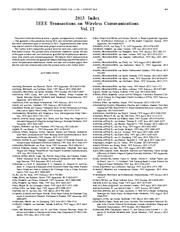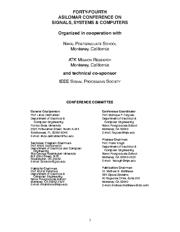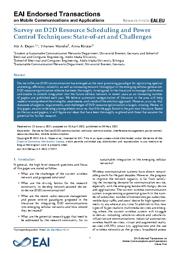A copy of this work was available on the public web and has been preserved in the Wayback Machine. The capture dates from 2020; you can also visit the original URL.
The file type is application/pdf.
Filters
Practical interference alignment and cancellation for MIMO underlay cognitive radio networks with multiple secondary users
2013
2013 IEEE Global Communications Conference (GLOBECOM)
We consider a MIMO underlay cognitive radio network with a single PU and multiple SUs. ...
In the underlay cognitive radio approach, secondary users (SUs) are allowed to transmit their messages as long as the negative impact on the performance of the primary user (PU) is below a certain threshold ...
CONCLUSION We consider a MIMO underlay cognitive radio network with a single PU and multiple SUs. ...
doi:10.1109/glocom.2013.6831206
dblp:conf/globecom/XuMS13
fatcat:6w4uga5z7zazthx6drredoidsm
Blind Null-space Tracking for MIMO Underlay Cognitive Radio Networks
[article]
2012
arXiv
pre-print
Blind Null Space Learning (BNSL) has recently been proposed for fast and accurate learning of the null-space associated with the channel matrix between a secondary transmitter and a primary receiver. ...
simultaneously learning the null-space of the time-varying target channel. ...
ACKNOWLEDGMENT The authors would like to thank Konstantinos Dimou for helpful discussions and suggestions. ...
arXiv:1204.0029v1
fatcat:nled4e5q7fhobblro7odawe5aa
2013 Index
2014
IEEE Transactions on Wireless Communications
The Author Index contains the primary entry for each item, listed under the first author's name. ...
Note that the item title is found only under the primary entry in the Author Index. ...
., +, TWC January 2013 333-345 Blind Null-Space Learning for MIMO Underlay Cognitive Radio with Pri-mary User Interference Adaptation. ...
doi:10.1109/twc.2011.09.499-tw1401-index
fatcat:w5ya5mg3sbcodb2crtuaoyk3su
Blind Null-Space Learning for MIMO Underlay Cognitive Radio Networks
[article]
2012
arXiv
pre-print
This paper proposes a blind technique for MIMO cognitive radio Secondary Users (SU) to transmit in the same band simultaneously with a Primary User (PU) under a maximum interference constraint. ...
with the SU. ...
BLIND NULL SPACE LEARNING VIA THE CYCLIC JACOBI TECHNIQUEIn this section we present a Blind Null Space Learning (BNSL) algorithm for solving the blind null space learning problem based on Theorems 1-2 ...
arXiv:1202.0366v1
fatcat:hlevk6zmmvh27nnetksdkb5bj4
2020 Index IEEE Transactions on Vehicular Technology Vol. 69
2020
IEEE Transactions on Vehicular Technology
+ Check author entry for coauthors ami-mFading Channels With Integer and Non-Integerm; TVT March 2020 2785-2801 Hoang, T.M., Tran, X.N., Nguyen, B.C., and Dung, L.T., On the Performance of MIMO Full-Duplex ...
Relaying System With SWIPT Under Outdated CSI; TVT Dec. 2020 15580-15593 Hodtani, G.A., see Gholami, R., TVT Sept. 2020 9938-9950 Hoki, K., see Kawakami, T., TVT Dec. 2020 16168-16172 Hong, C., ...
Novel Downlink Interference Alignment Method for Multi-User MIMO System With No CSIT: A Space-Time Coding Approach. ...
doi:10.1109/tvt.2021.3055470
fatcat:536l4pgnufhixneoa3a3dibdma
A Journey from Improper Gaussian Signaling to Asymmetric Signaling
2020
IEEE Communications Surveys and Tutorials
The journey begins from the design of improper Gaussian signaling in the interference-limited communications and leads to a more elaborate and practically feasible asymmetric discrete modulation design ...
As such, the theory of impropriety has vast applications in medicine, geology, acoustics, optics, image and pattern recognition, computer vision, and other numerous research fields with our main focus ...
Radio
Interweave
Cognitive Radio
Underlay
Cognitive Radio
Eavesdroppers
Sensing
and Detection
Communication
Network
Illegitimate links
Interference links
Self-Interference
Two-Way link ...
doi:10.1109/comst.2020.2989626
fatcat:zyno7ku6n5eqnp6rrcopczb4qu
Interference Alignment for Cognitive Radio Communications and Networks: A Survey
2019
Journal of Sensor and Actuator Networks
interference to the licensed users. ...
Thus, the concept of introducing interference alignment in cognitive radio has become a very attractive proposition. ...
Figure 2 . 2 Multiuser cognitive radio (CR) network model consisting of one primary user (PU) link and multiple secondary users (SUs)-Paradigm 1. ...
doi:10.3390/jsan8040050
fatcat:f7v6mxmku5gmtjuzcl64zvo2rm
Design and implementation of spatial interweave LTE-TDD cognitive radio communication on an experimental platform
2013
IEEE wireless communications
Targeting a real-time implementation of LTEbased cognitive radio, we focus on spatial interweave cognitive radio, in which a secondary user uses an antenna array to perform null-beamforming in the primary ...
Hence, to enable wide adoption of cognitive radio, using LTE as the physical layer is a natural choice. ...
INTRODUCTION Cognitive radio (CR) approaches [1] are increasingly highlighted due to the concern for radio spectrum optimization. ...
doi:10.1109/mwc.2013.6507395
fatcat:4huj4eeiw5bldiupqkqoyjnbkm
Design of large polyphase filters in the Quadratic Residue Number System
2010
2010 Conference Record of the Forty Fourth Asilomar Conference on Signals, Systems and Computers
We consider a cognitive radio network with K participating cognitive radios and one fusion center in the presence of one primary user and one jammer in the operating region. ...
WA2a-2 8:40 AM Learning Based Mechanisms for interference Mitigation in Self-organized Femtocell Networks
WA2a-3 9:05 AM Spectrum Allocation and power Control in oFDM-Based Cognitive Radios with Target ...
doi:10.1109/acssc.2010.5757589
fatcat:ccxnu5owr5fyrcjcqukumerueq
I/Q Interference in Device-to-Device Underlay Communication with Uplink Power Control
2015
2015 IEEE 81st Vehicular Technology Conference (VTC Spring)
A discrete rate link adaptation scheme is proposed to maximize the average spectral efficiency of the cognitive radio, while minimum average spectral efficiency for the primary user is provisioned [130 ...
Referring to this being the basic MIMO transmission method in LTE, one may learn that significant gains can be achieved with I/Q aware link adaptation. 465.2.1 Device-to-Device CommunicationDevice-to-Device ...
doi:10.1109/vtcspring.2015.7145866
dblp:conf/vtc/OruthotaT15
fatcat:e7fhilzchzf45nceolgcztjvqa
Interference Constraint Active Learning with Uncertain Feedback for Cognitive Radio Networks
2017
IEEE Transactions on Wireless Communications
In this paper, an intelligent probing method for interference constraint learning is proposed to allow a centralized Cognitive Radio Network (CRN) access the frequency band of a Primary User (PU) in an ...
underlay cognitive communication scenario. ...
TABLE I : I Definitions of Abbreviations Abbreviation
Description
PU
Primary User
SU
Secondary User
CBS
Cognitive Base Station
CRN
Cognitive Radio Network
AL
Active Learning
PBA
Probabilistic ...
doi:10.1109/twc.2017.2701361
fatcat:kvcaduwzfzbdjpjfjqyttrakmy
The One-Bit Null Space Learning Algorithm and Its Convergence
2013
IEEE Transactions on Signal Processing
This paper proposes a new algorithm for MIMO cognitive radio Secondary Users (SU) to learn the null space of the interference channel to the Primary User (PU) without burdening the PU with any knowledge ...
The asymptotic analysis and the derived bounds also apply to the recently proposed Blind Null Space Learning Algorithm. ...
In [4] , we proposed the Blind Null Space Learning Algorithm (BNSLA), which enables a MIMO underlay CR to learn the null space of H ps without learning the full matrix. ...
doi:10.1109/tsp.2013.2278155
fatcat:5vpdkjtodbed3k6vzbr24f3hum
Spectrum Sensing for Cognitive Radio: Recent Advances and Future Challenge
2021
Sensors
Spectrum Sensing (SS) plays an essential role in Cognitive Radio (CR) networks to diagnose the availability of frequency resources. ...
With the advancement of telecommunication technologies, additional features should be ensured by SS such as the ability to explore different available channels and free space for transmission. ...
Cognitive Radio Application for 5G and Beyond 5G The 5th generation (5G) of mobile technologies is expected to provide users with Gbps communication, very low latency and high reliability. 5G networks ...
doi:10.3390/s21072408
pmid:33807359
pmcid:PMC8037136
fatcat:ng43mpg3ovhcjdzu7tdf6ysmbu
WPMC 2020 TOC
2020
2020 23rd International Symposium on Wireless Personal Multimedia Communications (WPMC)
Multiuser MIMO Systems High Beamforming Gain Precoding Weight Design Scheme with Null-Space Expansion for Multiuser Massive MIMO in Time-Varying Channels Improved Null-Space Expansion Scheme under Presence ...
Title
Speaker / Author
1
2
3
4
Paper
T-02: Cognitive Radio-1
Underlay Cognitive Radio Millimeter-Wave Spectrum
Access for In-Building Dense Small Cells in Multi-
Operator Environments Toward ...
doi:10.1109/wpmc50192.2020.9309514
fatcat:smhat7fixzaxdidzfneu4bcghu
Survey on D2D Resource Scheduling and Power Control Techniques: State-of-art and Challenges
2018
EAI Endorsed Transactions on Mobile Communications and Applications
D2D resource optimization scheme has been thoroughly investigated in the literature to manage interference and enable its smooth integration into the future cellular network in recent years as an increasing ...
Based on the surveyed papers, it will figure out ideas that have been thoroughly explored and those that assume the potential for further research. ...
This will enable the transmission of the cellular user data in the null space of the channels of other cellular users so that the interuse interference can be canceled out. ...
doi:10.4108/eai.4-5-2022.173977
fatcat:gm377lvhe5hn7nw3fwqvkui33u
« Previous
Showing results 1 — 15 out of 36 results











